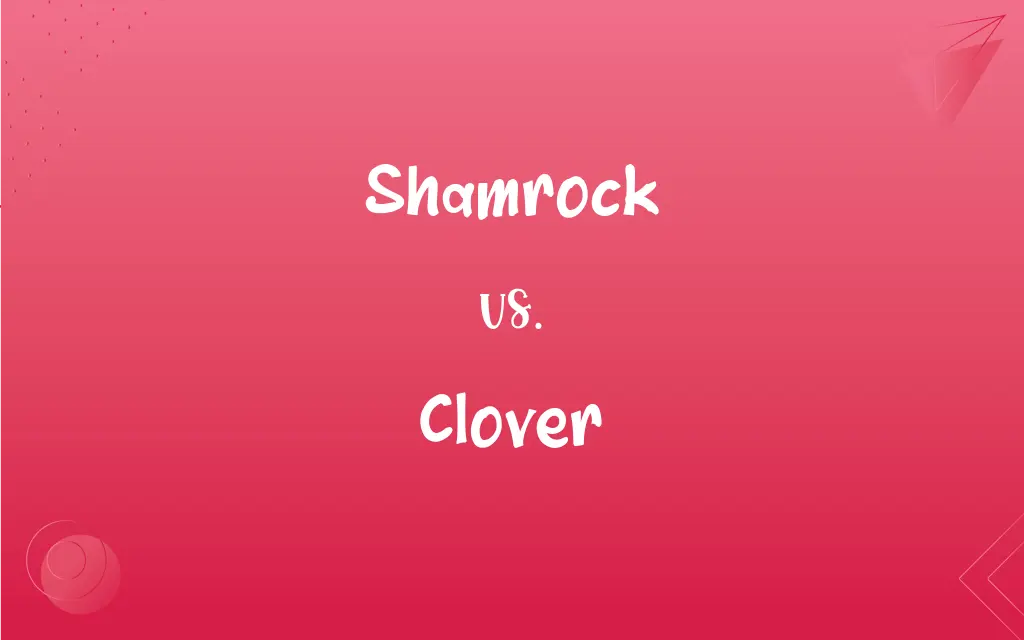Shamrock vs. Clover: What's the Difference?
Edited by Aimie Carlson || By Harlon Moss || Updated on October 15, 2023
Shamrock is a specific type of three-leaved clover often associated with Irish culture. Clover is a broader term encompassing various plants with three-lobed leaves.

Key Differences
Shamrock and clover are two distinct plants that are often associated with each other due to their similar appearance, but they have notable differences in terms of botanical classification, cultural significance, and symbolism. A shamrock typically refers to a specific species of clover and is associated with Ireland and St. Patrick's Day. In contrast, the term clover is a broader botanical category that encompasses various species within the Trifolium genus.
Shamrock, which is synonymous with the Irish culture, is specifically a type of clover known as Trifolium dubium. The word "shamrock" is derived from the Irish term "seamróg," meaning "little clover." It's a three-leaved plant with green leaves, and its association with Ireland can be traced back to St. Patrick, who is said to have used the shamrock to explain the concept of the Holy Trinity to the Irish. Today, the shamrock is a symbol of Irish identity and is closely linked to St. Patrick's Day celebrations.
Clover, on the other hand, is a more extensive category, encompassing a wide range of species, including Trifolium repens (white clover) and Trifolium pratense (red clover). Clovers are characterized by their distinctive three-lobed leaves and are found in many parts of the world. They are important for their nitrogen-fixing properties, making them valuable in agriculture. While clovers share some visual similarities with shamrocks, not all clovers are considered shamrocks, and shamrocks are typically a specific species of clover, as mentioned earlier.
Shamrock's cultural and symbolic significance is deeply rooted in Irish history and tradition. It's commonly worn on St. Patrick's Day as a symbol of Irish pride and heritage. People often wear shamrock-shaped jewelry, clothing, and accessories as a nod to their Irish ancestry. Additionally, the shamrock has been associated with good luck and is believed to ward off evil spirits. Its cultural significance extends beyond Ireland and is recognized worldwide as a symbol of Irish identity.
In contrast, clover has a more diverse range of uses and symbolism. Apart from being a food source for livestock and wildlife, clover has various agricultural and ecological applications due to its ability to fix nitrogen in the soil. Clover's symbolism varies from culture to culture; for some, it represents good luck, while for others, it signifies abundance and prosperity. In some cases, it's also associated with the idea of finding a rare four-leaf clover for good luck, which is not typically related to the shamrock.
ADVERTISEMENT
In conclusion, while shamrock and clover share visual similarities with their distinctive three-lobed leaves, they differ in their botanical classification, cultural significance, and symbolism. Shamrock refers specifically to Trifolium dubium and is deeply associated with Irish culture, particularly on St. Patrick's Day. Clover is a broader category that encompasses various Trifolium species with a more universal range of uses and symbolism. Understanding these differences helps appreciate the unique roles that shamrock and clover play in different contexts and cultures.
Comparison Chart
Definition
A three-leaved symbol of Ireland
A broad term for trifoliate plants
Cultural Significance
Associated with St. Patrick's Day
Not culturally specific
Species
Predominantly Trifolium dubium
Various species
Flower Color
Typically yellow
Varied flower colors
ADVERTISEMENT
Luck Symbol
Often considered lucky
Also seen as a symbol of luck
Shamrock and Clover Definitions
Shamrock
Associated with Irish heritage and folklore.
The shamrock is deeply rooted in Irish culture.
Clover
A generic term for trifoliate plants.
The field was covered in lush clover.
Shamrock
A cultural emblem representing the Holy Trinity.
The shamrock's three leaves symbolize the Father, Son, and Holy Spirit.
Clover
Considered a symbol of good luck in folklore.
Finding a four-leaf clover is said to bring luck.
Shamrock
A three-leaved plant symbolizing Ireland.
The shamrock is often worn on St. Patrick's Day.
Clover
Commonly found in lawns and pastures.
Clover provides excellent forage for livestock.
Shamrock
Historically linked to Druids and Celtic traditions.
Druids believed the shamrock had mystical properties.
Clover
Comes in various species with different characteristics.
Red clover has vibrant pinkish flowers.
Shamrock
Often used as a decorative motif in Irish art.
The shamrock design adorned the cover of the book.
Clover
Used in some cuisines and herbal remedies.
Clovers have both culinary and medicinal uses.
Shamrock
A plant having compound leaves with three small leaflets, especially a clover or wood sorrel.
Clover
Any of various herbs of the genus Trifolium in the pea family, having trifoliolate leaves and dense heads of small flowers and including species grown for forage, for erosion control, and as a source of nectar for honeybees.
Shamrock
The compound leaf of one of these plants.
Clover
Any of several other plants in the pea family, such as bush clover and sweet clover.
FAQs
What does the word "shamrock" mean?
Shamrock refers to a three-leaved clover, often symbolizing Ireland.
Is clover considered a symbol of luck?
Yes, finding a four-leaf clover is associated with good luck.
What is the difference between red clover and white clover?
Red clover has pinkish-purple flowers, while white clover has white flowers.
Where is clover commonly found?
Clover is prevalent in lawns, pastures, and fields.
Are there specific colors associated with shamrocks?
Typically, shamrocks have green leaves and yellow flowers.
What are the characteristics of clover plants?
Clover plants typically have trifoliate leaves and clustered flowers.
Are clovers considered weeds in lawns and gardens?
While some view them as weeds, others appreciate clovers for their nitrogen-fixing properties in soil.
Can you grow clover in your garden?
Yes, many people intentionally cultivate clover as a ground cover.
Are there any superstitions associated with clovers besides luck?
In some cultures, clovers are believed to ward off evil spirits and bring protection.
Why is the shamrock associated with St. Patrick's Day?
The shamrock is linked to St. Patrick, who used it to explain the Holy Trinity.
Is "shamrock" limited to one species?
Yes, it primarily refers to Trifolium dubium.
What cultural significance does the shamrock hold?
It's a symbol of Irish heritage and often considered lucky.
What is the general definition of "clover"?
Clover is a broad term for plants with trifoliate leaves.
How many species of clover are there?
There are various species, including white clover and red clover.
Are shamrocks found only in Ireland?
No, they can be found in other parts of the world but are culturally significant in Ireland.
Are all clovers edible?
Some clover species are edible and used in salads, while others are not.
Do all clovers have three leaves?
Most clovers have trifoliate leaves, but some variations may have more.
Are there historical connections between shamrocks and Druids?
Yes, shamrocks have been associated with Celtic and Druidic traditions.
Are clovers used for purposes other than symbolism?
Yes, they have culinary and medicinal uses in some cultures.
Why do people wear shamrocks on St. Patrick's Day?
To celebrate Irish culture and St. Patrick, who used the shamrock as a teaching tool.
How is the shamrock used in Irish art and design?
The shamrock motif is often incorporated into various forms of Irish art.
How do clovers benefit livestock?
They serve as valuable forage for cattle, sheep, and other animals.
Are there any medicinal uses for clover?
Red clover, in particular, has been used in traditional herbal remedies.
Is the shamrock a religious symbol?
Yes, it's often used to represent the Holy Trinity in Christianity.
Why is clover considered a symbol of good luck?
Finding a four-leaf clover is believed to bring good fortune.
About Author
Written by
Harlon MossHarlon is a seasoned quality moderator and accomplished content writer for Difference Wiki. An alumnus of the prestigious University of California, he earned his degree in Computer Science. Leveraging his academic background, Harlon brings a meticulous and informed perspective to his work, ensuring content accuracy and excellence.
Edited by
Aimie CarlsonAimie Carlson, holding a master's degree in English literature, is a fervent English language enthusiast. She lends her writing talents to Difference Wiki, a prominent website that specializes in comparisons, offering readers insightful analyses that both captivate and inform.































































